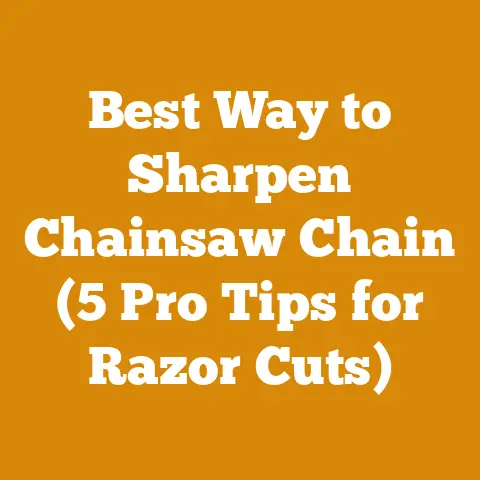Tree Stump Grinder (5 Pro Tips) for Efficient Wood Processing
“The best time to plant a tree was 20 years ago. The second best time is now.” – Chinese Proverb.
Understanding the Task: Tree Stump Grinding Demystified
Before diving into the “how,” let’s understand the “what” and “why.” Tree stump grinding is the process of mechanically reducing a tree stump and its immediate roots to small chips. This is typically done using a specialized machine called a stump grinder.
Why Grind Stumps?
- Aesthetics: Let’s face it, stumps are rarely beautiful. Grinding them away improves the overall appearance of your property.
- Safety: Stumps can be tripping hazards, especially for children and the elderly. They also attract pests like termites and carpenter ants, which can then infest your home.
- Usability: A stump occupies valuable space. Removing it allows you to reclaim that land for landscaping, construction, or simply enjoying your yard.
- Disease Prevention: Decaying stumps can harbor fungal diseases that can spread to other trees and plants on your property.
- Preventing Regrowth: Some tree species are notorious for sending up suckers from their roots long after the tree is cut down. Grinding the stump minimizes the chances of this happening.
Key Terms and Concepts
- Stump Grinder: A machine with a rotating cutting wheel equipped with hardened steel teeth designed to chip away at wood.
- Cutting Wheel: The heart of the stump grinder, this wheel spins at high speed and does the actual grinding.
- Teeth: The replaceable cutting edges on the cutting wheel. Different types of teeth are available for different types of wood and soil conditions.
- Swing Arc: The area the cutting wheel covers as it moves back and forth during grinding.
- Depth of Cut: The amount of material the cutting wheel removes in a single pass.
- Backfilling: The process of filling the hole left after grinding with soil, wood chips, or other materials.
- Green Wood vs. Seasoned Wood: Green wood is freshly cut wood with a high moisture content. Seasoned wood has been dried and has a lower moisture content. Grinding green wood is generally easier because it’s softer.
Pro Tip #1: Thorough Assessment and Preparation: The Foundation of Efficiency
Like any successful project, efficient stump grinding begins with careful planning. This involves a thorough assessment of the stump and its surroundings, followed by meticulous preparation. I’ve seen countless projects go sideways because someone skipped this crucial step.
Assessing the Stump
- Identify the Tree Species: Knowing the species of tree is critical. Some woods are harder than others, requiring different grinding techniques and potentially different teeth on your grinder. For example, grinding oak or maple will take longer than grinding pine or aspen.
- Personal Experience: I once spent an entire afternoon struggling to grind a particularly stubborn oak stump. Only later did I realize that I was using teeth designed for softer wood. Switching to carbide-tipped teeth made a world of difference.
- Measure the Stump’s Diameter and Height: This will help you determine the size of stump grinder you’ll need. Larger stumps require more powerful machines.
- Rule of Thumb: A stump grinder with a 25-horsepower engine is generally sufficient for stumps up to 24 inches in diameter. For larger stumps, consider a more powerful machine or renting a commercial-grade grinder.
- Inspect for Obstacles: Look for rocks, roots, buried pipes, cables, or other obstructions around the stump. These can damage the grinder and pose a safety hazard.
- Safety First: Call your local utility companies to mark any underground lines before you begin grinding. This is a free service and could prevent a potentially deadly accident.
- Evaluate the Soil Conditions: Is the soil sandy, rocky, or clay-rich? Rocky soil can dull the grinder teeth quickly. Clay-rich soil can become muddy and slippery when wet.
- Tip: If the soil is very rocky, consider removing as many rocks as possible before grinding. You can also try using a grinder with teeth specifically designed for rocky conditions.
- Check for Rot or Decay: If the stump is significantly rotted, it may be easier to break up with hand tools before grinding.
- Observation: Rotted wood is often softer and easier to grind, but it can also be more prone to throwing debris. Be sure to wear appropriate safety gear.
Preparing the Site
- Clear the Area: Remove any debris, such as branches, leaves, rocks, and other obstacles, from around the stump.
- Practical Advice: A clear work area not only improves safety but also allows you to move the grinder freely and efficiently.
- Protect Surrounding Vegetation: Cover any nearby plants or shrubs with tarps or plywood to protect them from flying debris.
- Personal Insight: I once accidentally damaged a client’s prize-winning rose bush while grinding a stump. Now, I always take extra precautions to protect surrounding vegetation.
- Establish a Safety Zone: Mark off a safety zone around the stump to keep bystanders away. A radius of at least 50 feet is recommended.
- Safety Reminder: Never allow anyone within the safety zone while the grinder is in operation.
- Prepare the Grinder: Check the grinder’s oil level, fuel level, and teeth for wear. Sharpen or replace any dull teeth.
- Maintenance Matters: Regular maintenance will keep your grinder running smoothly and efficiently.
- Gather Safety Gear: Always wear appropriate safety gear, including:
- Eye Protection: Safety glasses or a face shield to protect your eyes from flying debris.
- Hearing Protection: Earplugs or earmuffs to protect your ears from the loud noise of the grinder.
- Gloves: Heavy-duty gloves to protect your hands from splinters and abrasions.
- Long Pants and Sleeves: To protect your skin from flying debris.
- Steel-Toed Boots: To protect your feet from injury.
- Dust Mask or Respirator: To protect your lungs from dust and wood particles.
Pro Tip #2: Mastering the Grinding Technique: Efficiency in Motion
Once you’ve assessed the stump and prepared the site, it’s time to start grinding. The key to efficient grinding is to use the correct technique. This involves understanding how the grinder works and how to control its movement.
Understanding the Stump Grinder’s Operation
Most stump grinders operate on a similar principle. A rotating cutting wheel, powered by a gasoline or electric engine, is used to chip away at the wood. The operator controls the movement of the cutting wheel using a series of levers or handles.
The Sweeping Motion
The most common grinding technique involves using a sweeping motion. This means moving the cutting wheel back and forth across the stump in a controlled arc.
- Position the Grinder: Start by positioning the grinder so that the cutting wheel is slightly to one side of the stump.
- Engage the Cutting Wheel: Start the engine and engage the cutting wheel.
- Begin the Sweep: Slowly move the cutting wheel across the stump, using a smooth, controlled motion.
- Maintain a Consistent Depth: Try to maintain a consistent depth of cut with each pass. Avoid pushing the cutting wheel too hard into the wood, as this can overload the engine and damage the teeth.
- Overlap Each Pass: Overlap each pass slightly to ensure that you’re removing all of the wood.
- Lower the Cutting Wheel: As you grind down the stump, gradually lower the cutting wheel to grind deeper into the ground.
- Work in Layers: Work in layers, grinding down a few inches at a time. This is more efficient than trying to grind the entire stump in one pass.
- Practical Example: Imagine peeling an onion, removing one layer at a time. This is similar to how you should approach stump grinding.
- Grind Beyond the Surface: Grind the stump down to at least 6-12 inches below the ground surface. This will allow you to backfill the hole with soil and plant grass or other vegetation.
- Strategic Advantage: Grinding below the surface ensures that the roots are also removed, preventing future regrowth.
Adjusting the Grinding Technique
The optimal grinding technique will vary depending on the size and type of stump, as well as the soil conditions.
- Hardwood Stumps: Hardwood stumps, such as oak and maple, require a more aggressive grinding technique. Use sharper teeth and apply more pressure to the cutting wheel.
- Softwood Stumps: Softwood stumps, such as pine and aspen, are easier to grind. Use a lighter touch and avoid pushing the cutting wheel too hard.
- Rocky Soil: Rocky soil can dull the grinder teeth quickly. Use a slower grinding speed and avoid hitting rocks with the cutting wheel.
- Wet Soil: Wet soil can make the grinder difficult to control. Use a wider stance and be prepared to adjust your position as needed.
Avoiding Common Mistakes
- Overloading the Engine: Pushing the cutting wheel too hard into the wood can overload the engine and cause it to stall. Use a lighter touch and work in layers.
- Dulling the Teeth: Hitting rocks or other obstructions with the cutting wheel can dull the teeth. Be careful to avoid obstacles and sharpen or replace the teeth as needed.
- Grinding Too Fast: Grinding too fast can result in uneven grinding and a rough finish. Use a slower grinding speed and take your time.
- Neglecting Safety: Always wear appropriate safety gear and follow all safety precautions.
Pro Tip #3: Choosing the Right Stump Grinder: Match the Tool to the Task
Selecting the appropriate stump grinder is paramount for efficiency and safety. A machine that’s too small will struggle with larger stumps, while an overly powerful machine can be difficult to control and potentially dangerous.
Types of Stump Grinders
There are several types of stump grinders available, each with its own advantages and disadvantages:
- Handheld Stump Grinders: These are small, lightweight grinders that are ideal for small stumps and tight spaces. They are typically powered by a gasoline or electric engine and have a cutting wheel diameter of 8-12 inches.
- Pros: Portable, easy to maneuver, affordable.
- Cons: Limited power, not suitable for large stumps, can be tiring to operate.
- Tow-Behind Stump Grinders: These are larger grinders that are towed behind a vehicle. They are more powerful than handheld grinders and can handle larger stumps. They typically have a cutting wheel diameter of 12-20 inches.
- Pros: More powerful than handheld grinders, can handle larger stumps, more comfortable to operate.
- Cons: Less maneuverable than handheld grinders, require a vehicle for transport, more expensive.
- Self-Propelled Stump Grinders: These are the most powerful and versatile type of stump grinder. They are self-propelled, making them easy to maneuver, and they can handle even the largest stumps. They typically have a cutting wheel diameter of 20 inches or more.
- Pros: Very powerful, easy to maneuver, can handle even the largest stumps.
- Cons: Most expensive type of stump grinder.
- Hydraulic Stump Grinders (Attachment for Skid Steers/Tractors): These are powerful options that connect to existing machinery. They offer high torque and efficient grinding for larger projects.
- Pros: High power, good for large-scale operations, utilizes existing machinery.
- Cons: Requires existing equipment, can be expensive upfront.
Factors to Consider When Choosing a Stump Grinder
- Stump Size: The size of the stump is the most important factor to consider. Choose a grinder that is powerful enough to handle the largest stump you’ll be grinding.
- Engine Power: The engine power of the grinder is also important. A more powerful engine will allow you to grind stumps more quickly and efficiently.
- Cutting Wheel Diameter: The cutting wheel diameter determines the depth of cut. A larger cutting wheel will allow you to grind deeper into the ground with each pass.
- Portability: If you need to move the grinder frequently, choose a portable model that is easy to transport.
- Maneuverability: If you’ll be working in tight spaces, choose a grinder that is easy to maneuver.
- Budget: Stump grinders can range in price from a few hundred dollars to several thousand dollars. Choose a grinder that fits your budget.
- Teeth Type: Different teeth are designed for different materials (softwood, hardwood, rocky soil). Choose the right teeth for your specific needs. Carbide-tipped teeth are generally more durable and last longer.
Rental vs. Purchase
For occasional use, renting a stump grinder is often the most cost-effective option. However, if you plan to grind stumps frequently, purchasing a grinder may be a better investment.
- Cost Analysis: Calculate the cost of renting a grinder for each project versus the cost of purchasing a grinder and maintaining it. Factor in the time savings of owning your own grinder.
- Long-Term Value: Consider the long-term value of owning a grinder. You can use it for your own projects and even rent it out to others.
Pro Tip #4: Maintaining Your Stump Grinder: Longevity and Performance
A well-maintained stump grinder is a safe and efficient stump grinder. Regular maintenance will extend the life of your machine and ensure that it performs optimally.
Daily Maintenance
- Check the Oil Level: Check the oil level before each use and add oil as needed.
- Check the Fuel Level: Check the fuel level before each use and add fuel as needed.
- Inspect the Teeth: Inspect the teeth for wear and damage. Sharpen or replace any dull or damaged teeth.
- Clean the Grinder: Clean the grinder after each use to remove dirt, debris, and wood chips.
- Lubricate Moving Parts: Lubricate all moving parts, such as the cutting wheel bearings and the swing arm pivot points.
Weekly Maintenance
- Check the Air Filter: Check the air filter and clean or replace it as needed.
- Check the Spark Plug: Check the spark plug and clean or replace it as needed.
- Check the Belts: Check the belts for wear and damage. Replace any worn or damaged belts.
- Check the Tires: Check the tires for proper inflation and wear.
Monthly Maintenance
- Change the Oil: Change the oil and oil filter every month or after every 25 hours of use, whichever comes first.
- Grease Fittings: Grease all grease fittings.
Sharpening or Replacing Teeth
The teeth on a stump grinder are subjected to a lot of wear and tear. They will need to be sharpened or replaced periodically.
- Sharpening: You can sharpen the teeth using a grinder or a file. Be sure to follow the manufacturer’s instructions.
- Replacing: When the teeth are too worn to be sharpened, they will need to be replaced. Use the correct type of teeth for your grinder and follow the manufacturer’s instructions.
- Personal Tip: Keep a supply of spare teeth on hand so you can replace them quickly when needed.
Storage
When storing your stump grinder, be sure to:
- Clean it thoroughly.
- Drain the fuel tank.
- Disconnect the spark plug wire.
- Store it in a dry, protected location.
Pro Tip #5: Cleanup and Backfilling: Finishing the Job Right
The final step in efficient stump grinding is cleanup and backfilling. This involves removing the wood chips, filling the hole, and restoring the area to its original condition.
Removing Wood Chips
Once you’ve finished grinding the stump, you’ll be left with a pile of wood chips. These chips can be used for a variety of purposes, such as:
- Mulch: Wood chips make excellent mulch for gardens and landscaping.
- Compost: Wood chips can be added to your compost pile to help break down organic matter.
- Fuel: Wood chips can be used as fuel for wood-burning stoves or furnaces.
- Fill Material: Wood chips can be used to fill in low spots in your yard.
If you don’t want to use the wood chips, you can dispose of them at a local landfill or composting facility.
Backfilling the Hole
After removing the wood chips, you’ll need to backfill the hole. This can be done with soil, wood chips, or a combination of both.
- Remove Large Roots: Before backfilling, remove any large roots that are still visible in the hole.
- Add Soil: Fill the hole with soil, packing it down firmly.
- Add Wood Chips: Add a layer of wood chips on top of the soil to help retain moisture and prevent weeds.
- Level the Area: Level the area with a rake or shovel.
- Seed or Sod: Seed or sod the area to restore it to its original condition.
- Alternative: You can also plant flowers, shrubs, or trees in the area.
Restoring the Area
In addition to backfilling the hole, you may also need to restore the surrounding area. This may involve:
- Repairing any damage to the lawn or landscaping.
- Replacing any plants that were damaged during the grinding process.
- Cleaning up any debris that was scattered around the area.
Dealing with Large Root Systems
Sometimes, even after grinding the stump, you’ll find a network of large roots extending far beyond the stump’s original location.
- Manual Removal: For smaller roots, you can often remove them manually with a shovel and axe.
- Root Pruning: For larger roots, you may need to prune them back with a saw or loppers.
- Chemical Treatment: In some cases, you may need to use a chemical root killer to prevent regrowth. Be sure to follow the manufacturer’s instructions carefully.
Case Study: Transforming an Overgrown Yard
I once worked on a project where a homeowner had inherited a property with several large, unsightly tree stumps scattered throughout the yard. The stumps were not only an eyesore but also made it difficult to mow the lawn and enjoy the outdoor space.
- The Challenge: The stumps were from a variety of tree species, including oak, maple, and pine. They ranged in size from 12 inches to 36 inches in diameter. The soil was rocky and uneven.
- The Solution: I used a tow-behind stump grinder to grind the stumps down to 6 inches below the ground surface. I carefully assessed each stump and adjusted my grinding technique accordingly. I removed any large roots that were visible in the hole and backfilled the holes with a mixture of soil and wood chips. I leveled the areas and seeded them with grass.
- The Results: The homeowner was thrilled with the results. The stumps were gone, and the yard was transformed into a beautiful and functional outdoor space.
Strategic Insights for Efficient Wood Processing
Beyond the tactical steps, here are some strategic insights I’ve gained over the years:
A well-made stump grinder will last longer and perform better than a cheap one.
Next Steps: Putting Knowledge into Action
Now that you’ve learned the five pro tips for efficient tree stump grinding, it’s time to put your knowledge into action.
- Assess the Stumps on Your Property: Identify the tree species, measure the diameter and height, and inspect for obstacles.
- Choose the Right Stump Grinder: Select a grinder that is appropriate for the size and type of stumps you’ll be grinding.
- Prepare the Site: Clear the area, protect surrounding vegetation, and establish a safety zone.
- Master the Grinding Technique: Use the correct grinding technique for the type of stump you’re grinding.
- Maintain Your Stump Grinder: Keep your grinder well-maintained to ensure its longevity and performance.
- Cleanup and Backfill: Remove the wood chips, fill the hole, and restore the area to its original condition.
By following these steps, you can efficiently and safely grind tree stumps and reclaim your valuable outdoor space. Remember to always prioritize safety and take your time. With a little practice, you’ll be able to transform those frustrating stumps into usable space in no time. Happy grinding!






